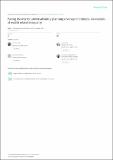| dc.contributor.author | Yigzaw, Muluneh | |
| dc.contributor.author | Zakus, David | |
| dc.contributor.author | Tadesse, Yehualashet | |
| dc.contributor.author | Desalegn, Muluked | |
| dc.contributor.author | Fantahun, Mesganaw | |
| dc.date.accessioned | 2021-08-26T09:39:19Z | |
| dc.date.available | 2021-08-26T09:39:19Z | |
| dc.date.issued | 9/14/2015 | |
| dc.identifier.citation | Yigzaw, M., Zakus, D., Tadesse, Y. et al. Paving the way for universal family planning coverage in Ethiopia: an analysis of wealth related inequality. Int J Equity Health 14, 77 (2015). https://doi.org/10.1186/s12939-015-0214-7 | en_US |
| dc.identifier.issn | 1475-9276 | |
| dc.identifier.uri | http://repository.amref.org/handle/123456789/149 | |
| dc.description | © 2015 Yigzaw et al. Open Access This article is distributed under the terms of the Creative Commons Attribution 4.0International License (http://creativecommons.org/licenses/by/4.0/), which permits unrestricted use, distribution, andreproduction in any medium, provided you give appropriate credit to the original author(s) and the source, provide a link tothe Creative Commons license, and indicate if changes were made. The Creative Commons Public Domain Dedication waiver(http://creativecommons.org/publicdomain/zero/1.0/) applies to the data made available in this article, unless otherwise stated | en_US |
| dc.description.abstract | Background: Family planning plays a significant role in reducing maternal and child mortality and ultimately in
achieving national and international development goals. It also has an important role in reducing new pediatric
HIV infections by preventing unwanted pregnancies among HIV positive women. Investing in family planning is
one of the smart investments for development as population dynamics have a fundamental influence on the
pillars of sustainable development, including that of a sustainable environment.
Objective: To identify and quantify wealth related differences in family planning use between poor and rich Ethiopian
women based on the Demographic and Health Survey asset based wealth quintiles.
Methods: The proportion of women who used contraceptives during implementation of the 2011 and 2005 Ethiopia
Demographic and Health Surveys was calculated across wealth quintiles. Data were stratified for place of residence to
analyze and determine inequalities in family planning use separately for rural and urban women. Socioeconomic
inequalities according to wealth were measured using the slope index of inequality and the relative index of inequality.
Result: The absolute difference of contraceptive prevalence between poorest and richest women was over 25.3
percentage points (95 % CI = 18.9-31.7) in 2011. Contraceptive use was more than twice (RII: 2.6, 95 % CI = 2.0 - 3.3)
as prevalent among the richest compared with the poorest.
Conclusion: Despite efforts to provide contraceptives for free at all public health facilities, wealth based inequalities
still prevail in Ethiopia. People at lower socioeconomic strata should be empowered more to avoid the root causes of
inequality and to achieve national Health Sector Development Program Goals. | en_US |
| dc.language.iso | en | en_US |
| dc.publisher | BioMed Central | en_US |
| dc.subject | Family planning | en_US |
| dc.subject | HIV | en_US |
| dc.subject | Maternal and child health | en_US |
| dc.subject | Ethiopia | en_US |
| dc.subject | Demographic and Health Surveys | en_US |
| dc.subject | Socioeconomic | en_US |
| dc.title | Paving the Way for Universal Family Planning Coverage in Ethiopia: an Analysis of Wealth related inequality | en_US |
| dc.type | Article, Journal | en_US |

